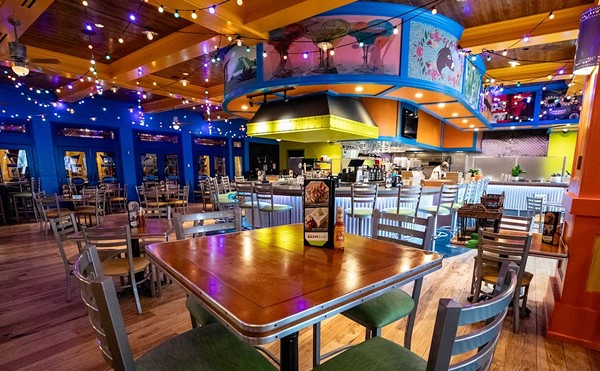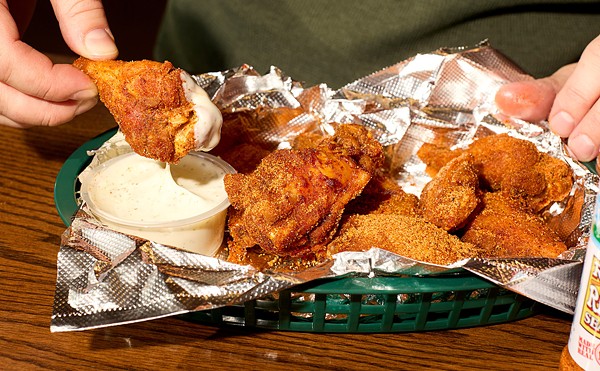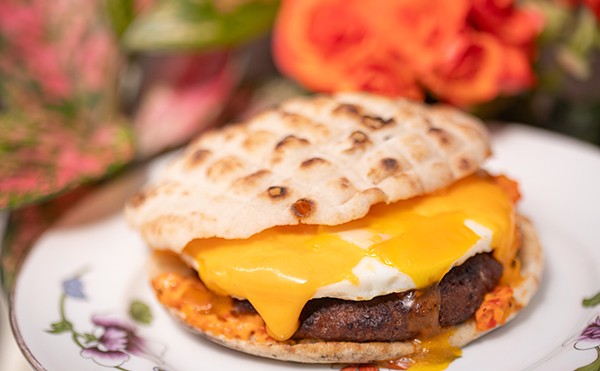This is clever, I thought. It shows that the kitchen has a playful side — not exactly what you expect from an Indian restaurant — and it might appeal to those unfamiliar with the cuisine and unsure what to try first.
Jalapeño poppers have gotten a bad rap, thanks to the batter-gnarled blobs of up-from-frozen bland served up by the T.J. O'Pootertoot's of the world, but the science is sound. Chile peppers? Awesome. Stuffed chile peppers? Also awesome. Battered and deep-fried anything? Awesome. (Usually. For an exception see: White Castle Slyders®, deep-fried, at GCS Stadium in Sauget.)
Rasoi's popper is enjoyable. The chile's bite, the shrimp's succulence and the coconut's mild sweetness work well together, and the fried batter hits the tempura-like balance between crisp and light. My only quibble was the use of an Anaheim chile. I wanted more heat.
It was precisely this craving that led to my epiphany of the obvious: Crappy, inexplicably popular American bar-and-grill chains didn't invent the "popper." The name, maybe, but not the concept. When I reviewed the Indian restaurant Saffron last year ("Raita On," November 7, 2007), one of my favorite dishes was andheri mirchi bhajji, battered and deep-fried (and hot) banana peppers stuffed with a mixture of coconut and sesame seeds.
In food, as in the arts, influence isn't always linear. It's a give-and-take between recipes and traditions hundreds or even thousands of years old and the rapidly shrinking modern world that globalization, for better or worse, has brought us.
All you need to do is spend a minute watching the images flashing across the flat-screen TV in Rasoi's bar. The footage, whether a soap opera or an ad for the latest Bollywood spectacle, will likely inspire a twinge of déjà vu. The camerawork is swooping and fast-paced, often frenetic. The cuts are quick, sometimes jarringly so. It feels American, that stylized approach that has leached from MTV into everything from high cinema to Food Network bake-offs. Then, as you drive home, tune to the pop or hip-hop station and listen closely. You might hear Indian dance music in the inescapable work of Timbaland.
Here's another example from Rasoi's selection of appetizers: "Calcutta Fish and Chips." The impact of Indian cuisine on its former colonial occupier is well known. Your average middle-class British family is as likely to have a curry for dinner as anything else. I lived in England for a year, and I remember the grocery stores stocking frozen curries the way ours stock frozen pizzas or Lean Cuisine.
Rasoi's fish-and-chips dish smartly turns that influence on its head. Three strips of tilapia are dredged in a complexly spiced batter and then deep-fried. The result is so flavorful that you would never suspect the fish was boring old tilapia. On the side are masala-spiced "chips" (unfortunately more like boiled potatoes than French fries) and achaari tartar sauce. (Achaari refers to the spices used in pickling.) Like the "Bollywood Popper," it's clever, but not showy. At heart, it's still fried fish and potatoes. If it happens to remind you of how boring British cuisine would be without its Indian infusion, so much the better.
As you've probably gathered by now, Rasoi isn't your typical Indian restaurant. Technically, it's not new, either. It relocated from digs just around the corner in the Central West End. But from its canopied entrance to its striking interior to its highly stylized logotype, Rasoi feels new.
It's spacious, with two dining rooms; the bar is in a corner of the main dining room just inside the entrance. This main dining room, which has booths, tables and a banquette, has a welcome airy feel thanks to high ceilings and large windows. I especially liked the light fixtures that resemble pumpkins and the ceiling fan above the bar, which looks sort of like a cross between a traditional ceiling fan and a Calder mobile. Large, brightly colored photographs of Indian scenes decorate the walls.
Though lengthy by American standards, Rasoi's menu is relatively restrained compared to what you typically find at Indian restaurants. It ranges from the whimsical appetizers I've described to more traditional dishes like tandoori chicken, lamb rogan josh and vindaloo. The most distinguishing aspects are price and the presentation. A few selections approach $20, and the kitchen plates many dishes in a style reminiscent of New American cuisine.
(Those who relish the more casual Indian-restaurant experience should know that the basmati rice is still served in a large communal dish, the excellent naan in a basket.)
From among the tandoori dishes, I tried both the masaledar lamb chops and the chicken tikka lal mirch. The lamb was fantastic, the four chops small but plump. The meat, by nature or on account of its yogurt marinade, was very tender, and the spice mixture was more complex than I usually associate with tandoori cooking, with both the heat of chiles and the warmth of cinnamon and nutmeg. The chicken, though just as tender, lacked that complexity. It was much too salty.
Game hen was served atop a large mound of rice pilau (pilaf) studded with pistachios; on the side were curried vegetables. The hen was moist and richly flavored, but the sauce was muddled and lacked spark. Still, it was cool to see an entrée with some ambition, rather than yet one more take on vindaloo.
Then again, there's certainly nothing wrong with a good vindaloo sauce, and Rasoi's, which I tried with chicken from the lunch buffet, is tasty, with a definite vinegar edge. My favorite of the more traditional dishes at Rasoi is a toss-up between the lamb rogan josh and the palak paneer. The rogan josh offered hunks of lamb nearly as tender as the masaledar chops, in an elegant sauce that hinted at cardamom and cumin and other spices without letting one flavor dominate.
The palak paneer, cubes of homemade cheese in creamed spinach, had a lovely silken texture and verdant flavor. Though my game hen came with a generous serving of vegetables, I found myself spooning palek paneer onto my naan again and again. Of course, few cuisines are as vegetable-friendly as Indian, and for $16 Rasoi offers a sampler of vegetable dishes including palak paneer, the flavorful lentil dish dal makhani and a light, crisp vegetable samosa.
Longtime favorites like palak paneer are so satisfying that it's hard to fault Indian restaurants that don't vary from the standard template. Sleek looks aside, Rasoi doesn't venture too far from that template. But I'm excited to encounter an Indian restaurant that considers the cuisine's present and future as much as its past.
It's certainly a better step forward than my plan to sneak into T.G.I. Bennihan's and replace the jalapeño poppers with stuffed banana peppers.
The soccer moms would freak.
Have a suggestion for a restaurant the Riverfront Times should review? E-mail [email protected].
For more about food and St. Louis restaurants, visit Gut Check: blogs.riverfronttimes.com/gutcheck.





